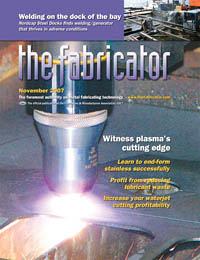- FMA
- The Fabricator
- FABTECH
- Canadian Metalworking
Categories
- Additive Manufacturing
- Aluminum Welding
- Arc Welding
- Assembly and Joining
- Automation and Robotics
- Bending and Forming
- Consumables
- Cutting and Weld Prep
- Electric Vehicles
- En Español
- Finishing
- Hydroforming
- Laser Cutting
- Laser Welding
- Machining
- Manufacturing Software
- Materials Handling
- Metals/Materials
- Oxyfuel Cutting
- Plasma Cutting
- Power Tools
- Punching and Other Holemaking
- Roll Forming
- Safety
- Sawing
- Shearing
- Shop Management
- Testing and Measuring
- Tube and Pipe Fabrication
- Tube and Pipe Production
- Waterjet Cutting
Industry Directory
Webcasts
Podcasts
FAB 40
Advertise
Subscribe
Account Login
Search
6 structural steel lessons not found in books
Frank advice on fixing some 'structural' mistakes made in steel fab shops
- By Jim Caudle
- November 6, 2007
- Article
- Shop Management
Someone who fabricates plate products in the world of structural steel has to have an open mind. Think about it. "Structural" applies to beam and columns for steel-framed buildings; framing accessories such as clip angles, base plates, and angle bracings; and ornamental fabrications that are meant to accentuate a building design and support it. Basically, you need to know a little about everything.
For example, you need to know how to check for quality. After placing holes in a structural beam, a fabricator needs to confirm the holes' locations. The work points are critical between the structural shape and the framing accessories, and the slightest mistake can lead to trouble during field erection.
In another example, you need to know about tack welding, the basic joining method for most structural steel projects. You will need to turn the welding machine heat up to prevent slag and to ensure you penetrate with the gas metal arc tack welds. The first tack weld will be small and the next one bigger, about 1/2 inch, which is then followed by a solid weld that is as big as the biggest tack. This keeps tack welds from popping loose.
Before welding solid, it's time to put the quality hat back on. Always check holes and framing accessories after tack welding. That way you won't have to spend all day removing solid welds if something is out of place. Just breaking three or four tack welds is a lot easier.
Unfortunately, this type of structural steel education is not taking place. Trade and welding schools give you the basics about fabricating, but you learn a lot more on the job.
But some of those lessons are not taught even in the structural steel fabricating shops anymore. Experienced workers are not as plentiful as they once were, and those with communication skills and the patience to educate the next generation of fabricators are rare. Articles that provide critical information about structural steel fabrication can help, but it's important that fabricators have good shop floor training programs to accompany the good advice provided by these trade publications.
After 35 years in the industry, a structural steel fabricator should be able to provide some insight into what makes a good shop and how it should run. Following is some advice for structural steel job shops to consider.
1. A Good Structural Steel Shop Usually Has a Good Foreman.
A good shop foreman who has the confidence of the company CEO, can communicate, and can lead the shop guys is worth his weight in gold. The foreman is often asked to lead fabrication jobs and pass along production tips and tricks to less experienced shop floor personnel. Knowledgeable foremen easily can win the respect of those companies that employ them, those who work for them, and customers who work with them.
Sometimes companies equate fabricating knowledge with an engineering degree. College graduates can bring a fresh perspective to a shop environment, but if the degreed individual has no fabricating experience—much less work experience—a credibility gap opens between those looking for fabricating leadership and the one expected to provide it.
In fact, the best foremen or candidates for such positions are the "old guys," those with the experience and knowledge that can help jobs run smoothly. Some went to drafting schools, and most worked at least a year in the fab shop before they moved into the detailing department. In some instances, those same fabricators who worked their way up own their own structural steel shops now.
At the very least, let the old guys stay. They should be made inspectors or instructors. They are allowed to make money on top of their Social Security benefits, after all.
Today, however, that's not the norm. The industry has more engineers who can read all the critical information, and more detailers who can put it on paper. But who is communicating with the shop floor to ensure the job can be fabricated according to the detailer's specs and in the time allotted?
2. Sometimes a Helper Isn't Much of a Help on a Deadline.
Here's a typical statement from the front office: "Here's 14 stories of four-line pipe rail. You need to have them ready for the erectors in three days. We'll get you a helper to finish the job on time."
That request is not unusual. The offer for assistance is a common refrain. The end result is usually a pain for the lead fabricator. Instead of spending time on the rush job, the lead fabricator has to spend time watching the helper.
For jobs with tight deadlines, dedicated, experienced hands are best. Helpers and those fabricators providing the training to the helpers can accomplish their goals by working on jobs with longer lead-times. The helper then can take it all in as he or she holds the dumb end of a tape measure. Watching the layout person and fitter do their jobs without the pressure of including someone not ready to contribute fully can lead to a relaxed exchange of knowledge.
What about the quick turnaround for the handrail job? Instead of possibly missing the deadline because of the need to help the helper, the fabricator can build the handrails to each different stringer, make the correct pitch or bevel on the returns, and match the handrails for a nice fit-up—all within the allotted time.
3. Bent Plate Can Be a Lifesaver in Moving Plate.
Worker safety should be paramount for companies, but that's not always the case. Some of the scariest moments in a structural steel shop occur when very large plates are handled sloppily.
In one structural steel shop, shop floor personnel were moving a heavy plate with a beam clamp, but the gripping teeth were packed with paint residue, which made the gripping area too smooth to pick up the plate effectively. The beam clamps dropped the plate, almost smashing a person.
That led to an important lesson. When picking up a plate, lay the plate down and use spreader chains with bent plates on the chains to grab all four edges. Do not use hooks on the ends of chains to move plate, and do not use clamps on painted material to avoid paint buildup.
4. Sometimes a Combination of Plate and Structural Shapes Is Better for a Particular Job Than Plate Alone.
Follow this example. A tube radius stringer—used in fabricating staircases—needs to be fabricated. The project starts with a 12-in. by 2-in. tube, which was made in-house by roll bending metal plate and welding it solid. To manufacture a 15-foot piece will apply severe stress to the tube's radius, resulting in ripples in the inside of the radius. What can be done to avoid the stress during bending?
One idea is to take a 12-in. channel and drill holes for bolts. Get the component rolled to the proper radius and put the plate inside the open edge of the stringer with 1-in.-spaced welds holding it in place. Nonwelded spaces can be finished off. In the meantime the stringer maintains its structural integrity.
Sometimes jobs don't go exactly as the front office imagines. But a simple twist on how to fabricate a part still can result in engineering's approval.
5. Let the Concrete Dry.
On a lot of jobs, the goal is to rush, rush, rush. The end result is often rework, rework, rework.
When working with concrete, let it dry, get the correct field measurements, and do the structural work. Don't build the handrails before the concrete is even poured because the effort likely will be wasted. A lot can happen between plans and on-site construction, and a few inches in structural layout can translate into scrapped components if they are made too soon.
6. Standardize on Hand Tools.
Many job shops have relied on layout tools that were created in-house by the veterans who are now leaving the fabricating industry. The tools did the job, but shops sometimes ran into problems as a fitter might have a slightly different hand tool than his co-worker across the shop floor.
A simple search on the Internet reveals inexpensive tools that can allow a shop to standardize on one style of hand tool to perform consistent and accurate layout of structural steel components. Such a standardized approach will reduce erection time in the field.
About the Author
Jim Caudle
526A Paradise Way West
Greenwood, IN 46143
317-883-1849
subscribe now

The Fabricator is North America's leading magazine for the metal forming and fabricating industry. The magazine delivers the news, technical articles, and case histories that enable fabricators to do their jobs more efficiently. The Fabricator has served the industry since 1970.
start your free subscription- Stay connected from anywhere

Easily access valuable industry resources now with full access to the digital edition of The Fabricator.

Easily access valuable industry resources now with full access to the digital edition of The Welder.

Easily access valuable industry resources now with full access to the digital edition of The Tube and Pipe Journal.
- Podcasting
- Podcast:
- The Fabricator Podcast
- Published:
- 04/16/2024
- Running Time:
- 63:29
In this episode of The Fabricator Podcast, Caleb Chamberlain, co-founder and CEO of OSH Cut, discusses his company’s...
- Trending Articles
Steel industry reacts to Nucor’s new weekly published HRC price

How to set a press brake backgauge manually

Capturing, recording equipment inspection data for FMEA

Are two heads better than one in fiber laser cutting?

Hypertherm Associates implements Rapyuta Robotics AMRs in warehouse

- Industry Events
16th Annual Safety Conference
- April 30 - May 1, 2024
- Elgin,
Pipe and Tube Conference
- May 21 - 22, 2024
- Omaha, NE
World-Class Roll Forming Workshop
- June 5 - 6, 2024
- Louisville, KY
Advanced Laser Application Workshop
- June 25 - 27, 2024
- Novi, MI



























